Genus Pheidole Westwood - key to major workers
| The Ants of
Egypt Genus Pheidole Westwood - key to major workers |
|
The definitions adopted by Eguchi (2001) are useful. A feature of the major workers that seems to be very useful in separating species is the size and arrangment of the teeth or processes on the hypostoma or hypostomal border on the anterior underside of the head. The first study to show these appears to be Eguchi's study of Bornean species. |
|
|
|
Pheidole major heads- hypostomal teeth permutations from a
maximum of a single median, paired submedian and paired lateral
(mesal, close to the mandibular base) |
Key to major workers from the circum-Mediterranean area - revised 2009 (following on Finzi, 1936: 165); OI - eye length/HL. |
| 1 | 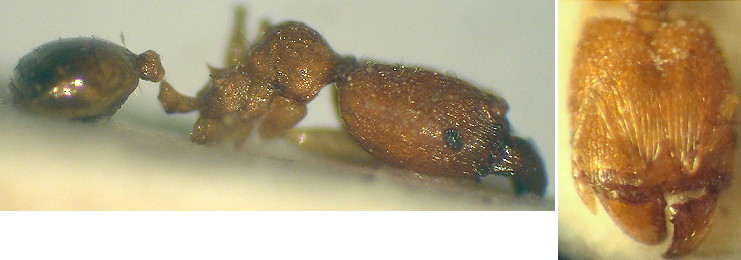 TL
2.8 mm; TL
2.8 mm; |
fadli |
| -- | TL ca 3.5-4.5 mm | 2 |
| 2 | Head with longitudinal striations reaching the occiput; frontal carinae long | 3 |
| -- | Longitudinal striations on head variable in intensity but never reaching back beyond the length of the scapes and no development of antennal scrobes | 4 |
| 3 | 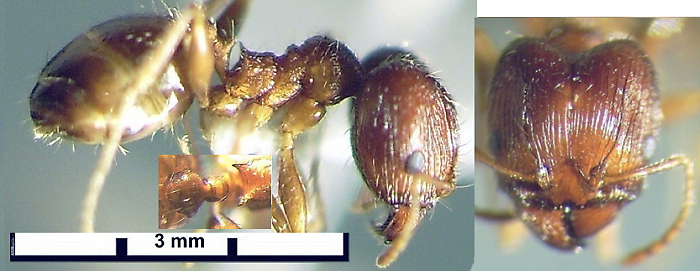 TL
ca 3.8-4.0 mm; CI 92-100, SI 60-65, OI 16-19; head with fine
longitudinal striations reaching the occiput; frontal carinae long and
strongly divergent posteriorly, reaching the posterior quarter of the
head and antennal scrobes distinct; mandibles smooth and shiny; clypeus
smooth and shiny without a distinct median longitudinal carina;
metanotum raised into a strong welt, metanotal groove wide; propodeal
spines robust; note the colour is quite variable from yellow-brown to
very dark brown in different colonies TL
ca 3.8-4.0 mm; CI 92-100, SI 60-65, OI 16-19; head with fine
longitudinal striations reaching the occiput; frontal carinae long and
strongly divergent posteriorly, reaching the posterior quarter of the
head and antennal scrobes distinct; mandibles smooth and shiny; clypeus
smooth and shiny without a distinct median longitudinal carina;
metanotum raised into a strong welt, metanotal groove wide; propodeal
spines robust; note the colour is quite variable from yellow-brown to
very dark brown in different colonies |
. |
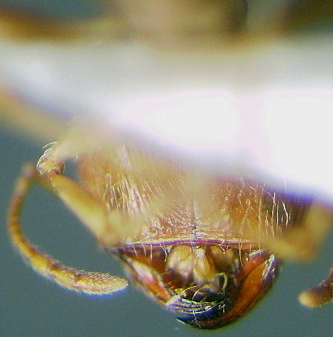 Hypostoma
with a small median tooth, small submedian teeth and small lateral
teeth; underside of head weakly striate and shiny; CI 100 SI 54 OI 19 "teneriffana"
in part Hypostoma
with a small median tooth, small submedian teeth and small lateral
teeth; underside of head weakly striate and shiny; CI 100 SI 54 OI 19 "teneriffana"
in part |
fervens | |
| -- | 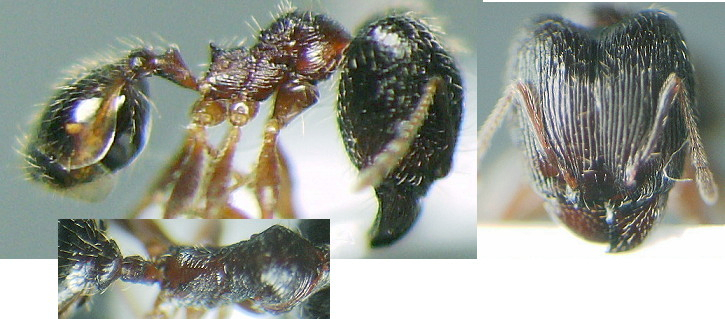 TL ca 4.5, CI 90-93, SI 52-58, OI 16, PPW/HW 46-49; head in full face
view with near straight sides, slightly diverging from front to back;
with a deeply impressed occiput; longitudinal striations reaching the
occiput and often strongly marked; with a distinct antennal scrobe that
has weakly spiculate base sculpture; frontal carinae long and almost
straight, diverging relatively little after widening immediately behind
the antennal insertion; the carinae reach almost to the occiput and
apically turn forwards to create a shallow but distinct scrobes; in
profile head evenly convex below, but angular above; in full face view
the vertex is distinctly impressed; antennae with both scapes and
funiculi slender but moderately long reaching back to the three-quarter
point of the head; the antennal club with three quite short, elongated
bead-like segments; eye quite small and near circular (10-11 facets long
X 10 wide); set 1.5 X its own length back from the lateral margin of
the clypeus; alitrunk profile irregular with a high domed pro-mesonotum;
there is a very distinct transverse welt on the mesonotum which angles
downwards posteriorly into a shallow but quite wide metanotal groove;
propodeum profile flat but sloping downwards from front to back, with
strong but narrow triangular teeth; from above it is distinctly margined
with a longitudinal impression that widens from front to back; petiole
in profile with a fairly long peduncle rising evenly from the anterior
to the top of the node; that is a moderately high oblique triangle with
the upper margin narrowly rounded and entire, the posterior face is near
vertical; postpetiole is small and globular in profile; from above it is
more than twice as wide as the petiole and has sharply conical lateral
apices; erect pilosity quite long, fine and abundant; on the front of
the head there is an abundance of thicker erect hairs; on the gaster the
hairs are shorter and even more abundant; the pubescence is short,
adpressed but quite sparse. The sculpturation on the anterior of the
head is of strong longitudinal striations with no reticulation, the
posterior of the head on the sides also is striated; the alitrunk, apart
from the pronotum dorsum which has fine curved transverse rugae, has
strong longitudinal striations overlying loose puncturation, the dorsum
of the propodeum is almost smooth. Overall quite shiny, with the gaster
very smooth and glossy; general colour is very variable from
yellow-brown to red-brown even to near black, with the gaster much the
same colour; funiculi, legs and mandibles are uniformly lighter than the
general colour
TL ca 4.5, CI 90-93, SI 52-58, OI 16, PPW/HW 46-49; head in full face
view with near straight sides, slightly diverging from front to back;
with a deeply impressed occiput; longitudinal striations reaching the
occiput and often strongly marked; with a distinct antennal scrobe that
has weakly spiculate base sculpture; frontal carinae long and almost
straight, diverging relatively little after widening immediately behind
the antennal insertion; the carinae reach almost to the occiput and
apically turn forwards to create a shallow but distinct scrobes; in
profile head evenly convex below, but angular above; in full face view
the vertex is distinctly impressed; antennae with both scapes and
funiculi slender but moderately long reaching back to the three-quarter
point of the head; the antennal club with three quite short, elongated
bead-like segments; eye quite small and near circular (10-11 facets long
X 10 wide); set 1.5 X its own length back from the lateral margin of
the clypeus; alitrunk profile irregular with a high domed pro-mesonotum;
there is a very distinct transverse welt on the mesonotum which angles
downwards posteriorly into a shallow but quite wide metanotal groove;
propodeum profile flat but sloping downwards from front to back, with
strong but narrow triangular teeth; from above it is distinctly margined
with a longitudinal impression that widens from front to back; petiole
in profile with a fairly long peduncle rising evenly from the anterior
to the top of the node; that is a moderately high oblique triangle with
the upper margin narrowly rounded and entire, the posterior face is near
vertical; postpetiole is small and globular in profile; from above it is
more than twice as wide as the petiole and has sharply conical lateral
apices; erect pilosity quite long, fine and abundant; on the front of
the head there is an abundance of thicker erect hairs; on the gaster the
hairs are shorter and even more abundant; the pubescence is short,
adpressed but quite sparse. The sculpturation on the anterior of the
head is of strong longitudinal striations with no reticulation, the
posterior of the head on the sides also is striated; the alitrunk, apart
from the pronotum dorsum which has fine curved transverse rugae, has
strong longitudinal striations overlying loose puncturation, the dorsum
of the propodeum is almost smooth. Overall quite shiny, with the gaster
very smooth and glossy; general colour is very variable from
yellow-brown to red-brown even to near black, with the gaster much the
same colour; funiculi, legs and mandibles are uniformly lighter than the
general colour |
. |
| . | 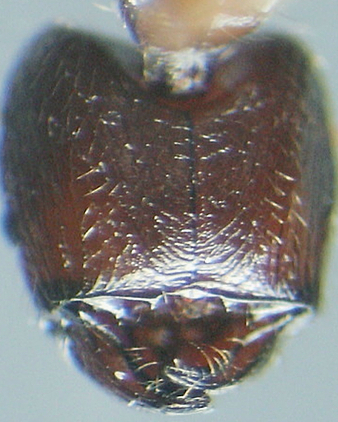 Mandibles
smooth and shiny but with distinct minute hair pits; clypeus also smooth
and shiny without a distinct median longitudinal carina; hypostoma with
no median tooth, moderately strong black submedian teeth and moderately
strong black lateral teeth; underside of the head weakly striate, with a
semicircular pattern anteriorly and shiny. "teneriffana"
in part Mandibles
smooth and shiny but with distinct minute hair pits; clypeus also smooth
and shiny without a distinct median longitudinal carina; hypostoma with
no median tooth, moderately strong black submedian teeth and moderately
strong black lateral teeth; underside of the head weakly striate, with a
semicircular pattern anteriorly and shiny. "teneriffana"
in part |
providens |
| . | Longitudinal striations on head variable in intensity but never reaching back beyond the length of the scapes and no development of antennal scrobes | . |
| 4 | Mandibles with coarse striation at least on the base; TL 4 mm plus | 5 |
| -- | Mandibles in most cases smooth and shiny, one with fine sculpturation; TL max 4 mm | 6 |
| 5 |  TL
ca 5 mm; CI 96 SI 55 OI 16; mandibles heavy and striated through their
whole length; coarsely so on the outer base, and with a thick inner,
masticatory edge; clypeus shiny but with strong longitudinal carina
which converge inwards from the anterior clypeal margin; frontal carinae
reaching back to behind the level of the eyes and almost parallel;
dorsum of pro-mesonotum near flat; dorsum of propodeum only weakly
margined and without a distinct longitudinal groove; most specimens dark
red-brown, some paler TL
ca 5 mm; CI 96 SI 55 OI 16; mandibles heavy and striated through their
whole length; coarsely so on the outer base, and with a thick inner,
masticatory edge; clypeus shiny but with strong longitudinal carina
which converge inwards from the anterior clypeal margin; frontal carinae
reaching back to behind the level of the eyes and almost parallel;
dorsum of pro-mesonotum near flat; dorsum of propodeum only weakly
margined and without a distinct longitudinal groove; most specimens dark
red-brown, some paler |
. |
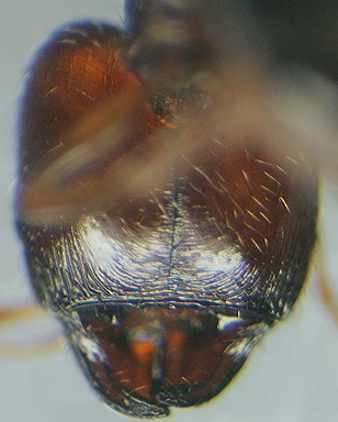 Hypostoma
with a black border bearing minute submedian teeth and large dark
lateral teeth; underside of head with weak semi-circular rugulation and
shiny Hypostoma
with a black border bearing minute submedian teeth and large dark
lateral teeth; underside of head with weak semi-circular rugulation and
shiny |
laticeps | |
| -- | 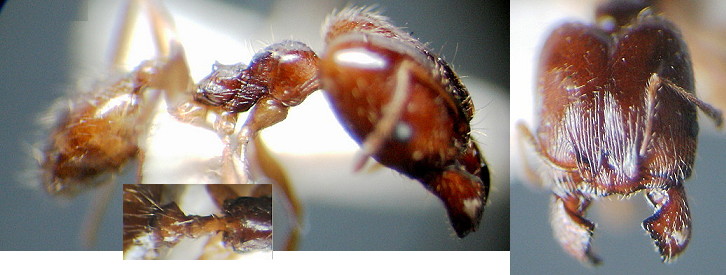 TL
4.0-4.5 mm; CI 100 SI 55 OI 12; frontal carinae reaching the mid-point
of the face and weakly divergent; mandibles quite large and heavy but
with a thin inner, masticatory margin; two basal teeth and two sharp
apical teeth; sculptured basally with rugae but dorsally with fine
striations and distinctive minute hair pits giving rise to an abundance
of short, thickish decumbent hairs; propodeum dorsum with sharp lateral
margins and a distinct longitudinal groove which widens from front to
back;dark red-brown, with the gaster and mandibles darker TL
4.0-4.5 mm; CI 100 SI 55 OI 12; frontal carinae reaching the mid-point
of the face and weakly divergent; mandibles quite large and heavy but
with a thin inner, masticatory margin; two basal teeth and two sharp
apical teeth; sculptured basally with rugae but dorsally with fine
striations and distinctive minute hair pits giving rise to an abundance
of short, thickish decumbent hairs; propodeum dorsum with sharp lateral
margins and a distinct longitudinal groove which widens from front to
back;dark red-brown, with the gaster and mandibles darker |
.. |
| . | 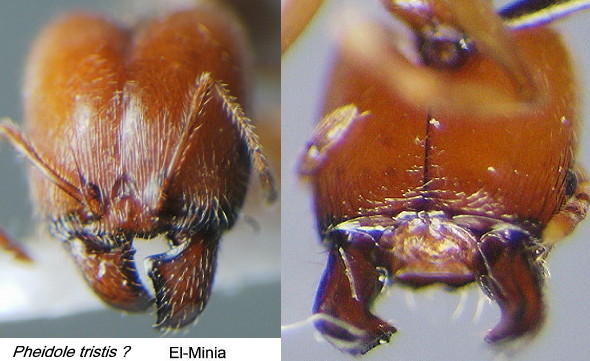 Hypostoma
with minute submedian teeth and large lateral teeth; underside of head
with very weak transverse anterior rugulation and shiny; clypeus shiny
with numerous longitudinal carinae but only a poorly defined median
carina Hypostoma
with minute submedian teeth and large lateral teeth; underside of head
with very weak transverse anterior rugulation and shiny; clypeus shiny
with numerous longitudinal carinae but only a poorly defined median
carina |
tristis |
| 6 |  With
the postpetiole simply ovoid/globular when viewed from above and not
much wider than the petiole With
the postpetiole simply ovoid/globular when viewed from above and not
much wider than the petiole |
7 |
| -- |  With
the postpetiole at least weakly rhomboid when viewed from above With
the postpetiole at least weakly rhomboid when viewed from above |
8 |
| 7 | 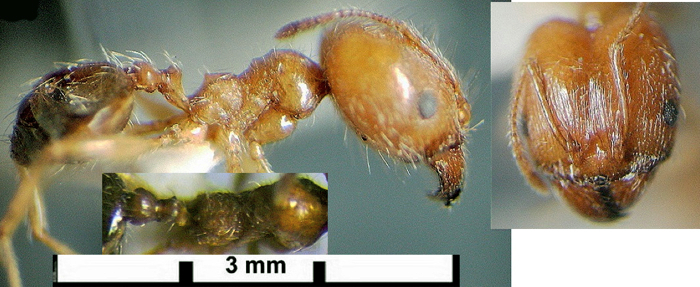 TL ca 5 mm; CI 97 SI 60 OI 18; funiculus segments 2-5 longer than wide;
head striated up to the anterior of the occiput with scapes reaching
back to the same level; only the posterior corners of the head forwards
to the deepest outside edge of the posterior edge of the head are
smooth; postpetiole in profile an obliquely angled oval (upper posterior
apex rearmost); yellow-brown, with gaster darker
TL ca 5 mm; CI 97 SI 60 OI 18; funiculus segments 2-5 longer than wide;
head striated up to the anterior of the occiput with scapes reaching
back to the same level; only the posterior corners of the head forwards
to the deepest outside edge of the posterior edge of the head are
smooth; postpetiole in profile an obliquely angled oval (upper posterior
apex rearmost); yellow-brown, with gaster darker |
. |
| . | 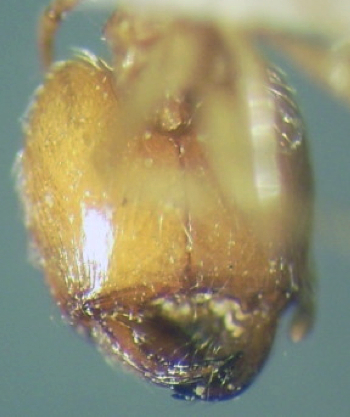 Hypostoma
with quite large submedian teeth but no median or lateral teeth;
underside of head almost smooth and shiny; clypeus smooth and shiny but
with a distinct median longitudinal carina; frontal carinae very short
and almost parallel; mandibles smooth and shiny Hypostoma
with quite large submedian teeth but no median or lateral teeth;
underside of head almost smooth and shiny; clypeus smooth and shiny but
with a distinct median longitudinal carina; frontal carinae very short
and almost parallel; mandibles smooth and shiny |
sinaitica |
| -- | 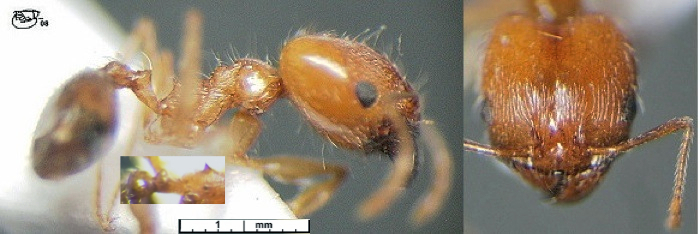 TL 3.7-4.0 mm; CI 95 SI 70 OI 22; funiculus segments 2-5 length = width;
eyes larger than sinaitica and twice as big as pallidula,
head striated less far back so that the scape reaches beyond the
striations, ; postpetiole profile almost circular; yellow-brown, with
gaster darker
TL 3.7-4.0 mm; CI 95 SI 70 OI 22; funiculus segments 2-5 length = width;
eyes larger than sinaitica and twice as big as pallidula,
head striated less far back so that the scape reaches beyond the
striations, ; postpetiole profile almost circular; yellow-brown, with
gaster darker |
. |
| . | 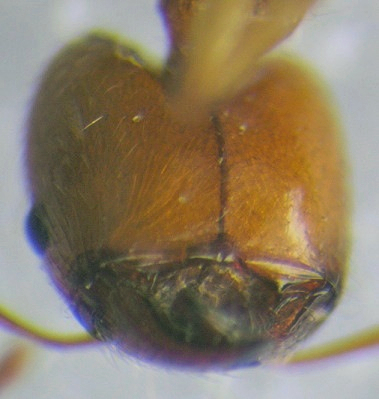 Hypostoma
bearing strong sharp submedian teeth set at centres of arcuate bases and
large dark lateral teeth; underside of head unsculptured and silky;
clypeus smooth and shiny but with a distinct median longitudinal carina;
frontal carinae reaching back behind the posterior of the eyes and
weakly divergent; mandibles smooth and shiny. Hypostoma
bearing strong sharp submedian teeth set at centres of arcuate bases and
large dark lateral teeth; underside of head unsculptured and silky;
clypeus smooth and shiny but with a distinct median longitudinal carina;
frontal carinae reaching back behind the posterior of the eyes and
weakly divergent; mandibles smooth and shiny. |
jordanica |
| 8 | Head in full-face view cordate, with quite strongly convex sides; CI at least 95 | 9 |
| -- | Head in full-face view sub-rectangular, with weakly convex sides; CI no more than 90 | 10 |
| 9 | 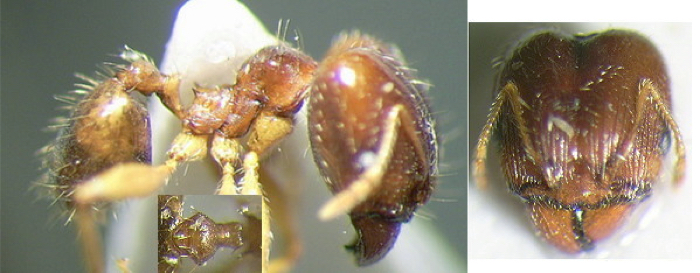 TL 4.0-4.5 mm (may be smaller) CI 96 SI 41 OI 14; promesonotum profile
uneven and somewhat angular, hexagonal when seen from above; propodeal
spines relatively large; postpetiole with an anterior ventral rounded
lobe (not present on members of the pallidula-group); lateral
propodeum and petiole densely spiculate less shiny; overall colour dark
yellow-brown;
TL 4.0-4.5 mm (may be smaller) CI 96 SI 41 OI 14; promesonotum profile
uneven and somewhat angular, hexagonal when seen from above; propodeal
spines relatively large; postpetiole with an anterior ventral rounded
lobe (not present on members of the pallidula-group); lateral
propodeum and petiole densely spiculate less shiny; overall colour dark
yellow-brown; |
, |
| . | 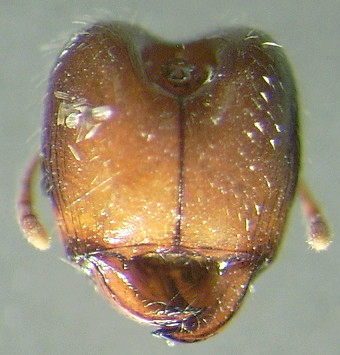 Hypostoma
with only a pair of lateral teeth; underside of head almost smooth
sculptured and shiny; clypeus smooth and shiny with a weak median
longitudinal carina; frontal carinae short and weakly divergent
posteriorly; mandibles smooth and shiny Hypostoma
with only a pair of lateral teeth; underside of head almost smooth
sculptured and shiny; clypeus smooth and shiny with a weak median
longitudinal carina; frontal carinae short and weakly divergent
posteriorly; mandibles smooth and shiny |
megacephala |
| -- |  TL 4.3 mm; CI 95 SI 54 OI 12; head in profile an extended oval tapering
significantly posteriorly; clypeus shiny with a distinct sharp
longitudinal carina; frontal carinae reaching the mid-point of the face
and almost parallel; mandibles smooth and shiny but with distinctive
hair pits; promesonotum profile smoothly domed, near circular when seen
from above; propodeal spines reduced to small sharp triangles; overall
colour red-brown or darker;
TL 4.3 mm; CI 95 SI 54 OI 12; head in profile an extended oval tapering
significantly posteriorly; clypeus shiny with a distinct sharp
longitudinal carina; frontal carinae reaching the mid-point of the face
and almost parallel; mandibles smooth and shiny but with distinctive
hair pits; promesonotum profile smoothly domed, near circular when seen
from above; propodeal spines reduced to small sharp triangles; overall
colour red-brown or darker; |
. |
| . | 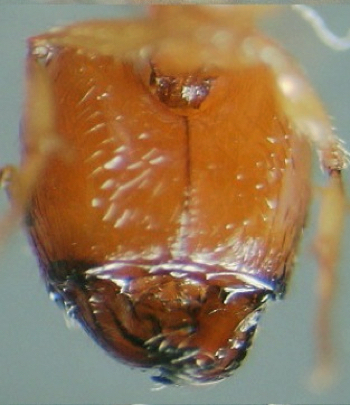 Hypostoma
with a distinct border, minute submedian and large lateral teeth;
underside of head with very weak semicircular rugulation and moderately
shiny; clypeus shiny with a distinct sharp longitudinal carina; frontal
carinae not reaching the mid-point of the face and almost parallel;
mandibles smooth and shiny but with distinctive hair pits. Hypostoma
with a distinct border, minute submedian and large lateral teeth;
underside of head with very weak semicircular rugulation and moderately
shiny; clypeus shiny with a distinct sharp longitudinal carina; frontal
carinae not reaching the mid-point of the face and almost parallel;
mandibles smooth and shiny but with distinctive hair pits. |
orientalis |
| 10 | 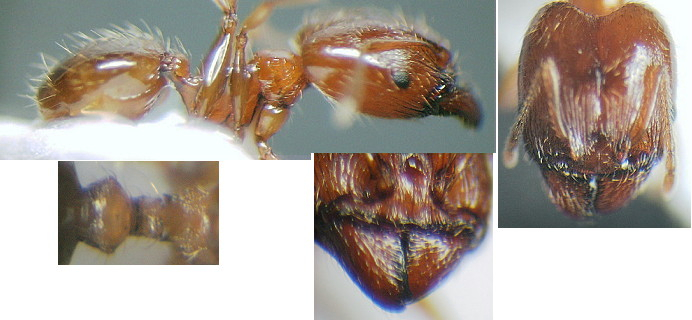 TL 3.4-3.9 mm; CI 85 SI 55 OI 12; clypeus shiny with a distinct sharp
longitudinal carina; frontal carinae reaching the mid-point of the face
and almost parallel; mandibles smooth and shiny but with distinctive
hair pits; overall colour red-brown or darker
TL 3.4-3.9 mm; CI 85 SI 55 OI 12; clypeus shiny with a distinct sharp
longitudinal carina; frontal carinae reaching the mid-point of the face
and almost parallel; mandibles smooth and shiny but with distinctive
hair pits; overall colour red-brown or darker |
. |
| . | 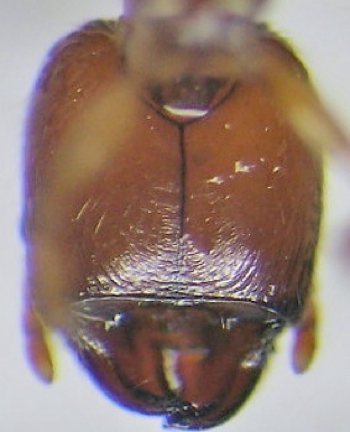 Hypostoma
with a black border with large lateral teeth but no median or submedian
teeth; underside of head with weak semicircular rugulation and
moderately shiny; clypeus shiny with a distinct sharp longitudinal
carina; frontal carinae reaching the mid-point of the face and almost
parallel; mandibles smooth and shiny but with distinctive hair pits. Hypostoma
with a black border with large lateral teeth but no median or submedian
teeth; underside of head with weak semicircular rugulation and
moderately shiny; clypeus shiny with a distinct sharp longitudinal
carina; frontal carinae reaching the mid-point of the face and almost
parallel; mandibles smooth and shiny but with distinctive hair pits. |
arenarum |
| -- | --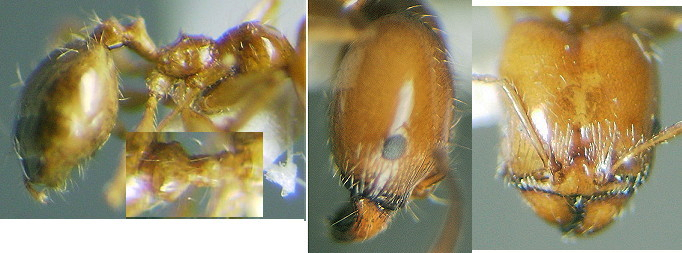 TL 3.4-3.9 mm; CI 90 SI 58 OI 14; lateral propodeum and petiole smooth
and shiny; clypeus smooth and shiny with a very weak median longitudinal
carina; frontal carinae very short but weakly divergent almost parallel;
overall colour pale yellow-brown, gaster often with a characteristic
pattern of ill-defined dark blotches;
TL 3.4-3.9 mm; CI 90 SI 58 OI 14; lateral propodeum and petiole smooth
and shiny; clypeus smooth and shiny with a very weak median longitudinal
carina; frontal carinae very short but weakly divergent almost parallel;
overall colour pale yellow-brown, gaster often with a characteristic
pattern of ill-defined dark blotches; |
. |
| . |  dark
form major apparently commensural withthe pale form, long-headed major dark
form major apparently commensural withthe pale form, long-headed major
|
. |
| . | 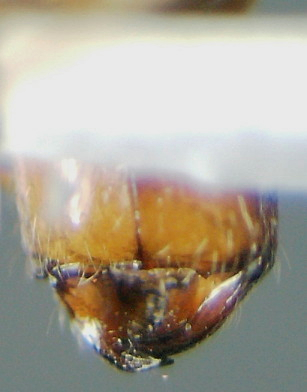 Hypostoma
with quite large lateral teeth but no median or submedian teeth;
underside of head almost smooth and shiny; clypeus smooth and shiny with
a very weak median longitudinal carina; frontal carinae very short but
weakly divergent almost parallel; mandibles smooth and shiny. Hypostoma
with quite large lateral teeth but no median or submedian teeth;
underside of head almost smooth and shiny; clypeus smooth and shiny with
a very weak median longitudinal carina; frontal carinae very short but
weakly divergent almost parallel; mandibles smooth and shiny. |
pallidula |
| © 2009, 2015 -
Brian Taylor CBiol FRSB FRES 11, Grazingfield, Wilford, Nottingham, NG11 7FN, U.K. |
href="pheidole_major_key.htm"